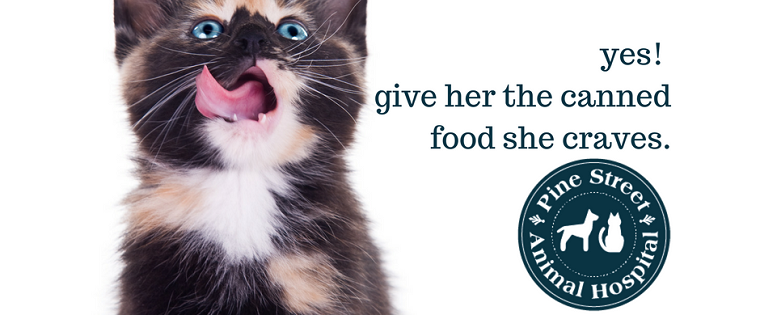What kind of food should I feed my cat?
Which is better, dry food or wet food?
Is wet cat food really bad for cats?
As veterinarians, we handle these questions all the time. But it turns out, we haven’t always answered them correctly. Years ago, we (and by we, I mean the veterinarians), told our patients that canned cat food was bad for cats and would make them fat and cause all their teeth fall out. Well, it turns out we were wrong about that. Very wrong. And now we’re ready to admit it.
Why vets used to prefer dry cat food.
I’ve mentioned in the past that as we have become closer to our pets by bringing them into our homes, we have seen not only an increase in life expectancy, but also an increase in more human-type diseases. We think now, and have thought for a while, that that was due to our pets living longer. And while that may be true to some extent, it is also because we are feeding them the same or very similar types of processed foods. But unless you either let your cats range free and fend for themselves, or hunt and kill prey for them to eat, what choice do we have? Very little—but there is a better solution.
Our unfounded theory that commercial dry cat food was better for cats wasn’t based on anything other than theory and speculation. We assumed the hard food was better for teeth, and that the higher fat content in canned food would make them, well, fat. So we pushed the dry food during annual exams and routine visits, and as a result, we have a population of cats with diabetes, obesity and lower urinary tract disease that manifests in chronic urinary tract infections.
Cats, like people, need diets lower in carbs.
What we have discovered through research is that cats, like people, are very sensitive to carbohydrates and can become extremely addicted to carbs in commercial dry cat foods. We also discovered that feline diabetes functions much the same way that type II diabetes functions in people—and is easily controlled by diet change.
In the not-too-distant past, if you had a cat that was diabetic, both of you were in for a lifetime of insulin injections, periodic bloodwork and glucose regulation curves. All of that is expensive, stressful and the opposite of fun. Now we know that by simply putting these cats on a diet based mostly in protein and fats (a more natural diet for felines), we can not only eliminate the need for insulin therapy, but we can reverse diabetes completely in the majority of these cats. The only ones that fail to convert are the ones who have been diabetic for so long that their insulin production and receptors are exhausted, so they still need a small dose of daily insulin to help.
Canned food for healthier cats
Another great side effect of moving to a canned food, protein- and fat-based diet is a healthier body weight and overall physical health. We will see dramatic decreases in obesity as well as a decrease in chronic skin issues. Also, the higher moisture contents of the wet foods aids in reducing the incidence of urinary tract disease which, as I said before, can manifest itself in chronic urinary tract infections, crystals in the urine and urethral obstructions that can be life threatening.
Medicine and research is always advancing and evolving. That’s one of the great things about what we do: we know that at some point, we will be able to do it better, safer and more efficiently. If you or someone you know has a cat with any of the above issues, please schedule an appointment with our veterinarians in Spartanburg to discuss how a diet change may help.
Find a list of canned cat food recommended by our veterinarians here.



